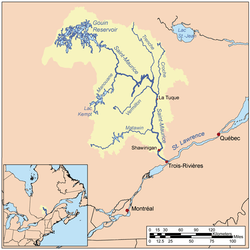Oskélanéo Lake
Oskélanéo Lake is a freshwater body linked to the southwestern part of the Gouin Reservoir (via Bureau Lake (Gouin Reservoir), in the territory of the town of La Tuque, in the administrative region of Mauricie, in the province of Quebec, in Canada.
| Oskélanéo Lake | |
|---|---|
 Watershed of Saint-Maurice River | |
| Location | La Tuque |
| Coordinates | 48°07′49″N 75°10′53″W |
| Type | Lake of dam |
| Primary inflows |
|
| Primary outflows | Oskélanéo River (tributary of Bureau Lake (Gouin Reservoir) |
| Basin countries | Canada |
| Max. length | 15.8 kilometres (9.8 mi) |
| Max. width | 2.9 kilometres (1.8 mi) |
| Surface elevation | 404 metres (1,325 ft) |
This lake extends entirely in the canton of Faucher. Following the completion of the Gouin Dam in 1948, the navigability between the Gouin Reservoir and Lake Oskélanéo becomes even easier with only two meters of difference in elevation.
Recreotourism activities are the main economic activity of the sector. Forestry comes second.
The Canadian National Railway (East-West) cuts Oskélanéo Lake in its middle through the village of Oskélanéo, located on the West Bank.
The route 404 serves the valley of the Oskélanéo River and connects to the Southeast at route 400 which connects the Gouin Dam and the village of Parent, Quebec, also serves the valleys of rivers Jean-Pierre and Leblanc; this road also serves the peninsula which stretches north in the Gouin Reservoir on 30.1 kilometres (18.7 mi). A few secondary forest roads are in use nearby for forestry and recreational tourism activities.
The surface of Oskélanéo Lake is usually frozen from mid-November to the end of April, however, safe ice circulation is generally from early December to late March.
Geography
- north side: Oskélanéo River, Bureau Lake (Gouin Reservoir);
- east side: Nemio River, Bouzanquet Bay, De La Galette River (Gouin Reservoir);
- south side: Gosselin River, Douville River, Bazin River;
- west side: Saraana Bay, Mégiscane River, Tessier Lake (Gouin Reservoir).
The Oskélanéo Lake is Haylow Bay advancing westward 2.1 kilometres (1.3 mi) near the mouth of the lake. This lake is mainly fed by the Parker and Froissart streams, as well as by the outlet of Hill Lake (via Haylow Bay) and the outlet (coming from the South) of Marcotte and Bisborne Lakes.
This lake is split in two by a strait (North-South direction) of 5.2 kilometres (3.2 mi), located north of the railway bridge spanning the lake at the height of the village of Oskélanéo.
The mouth of Lake Oskélanéo is located at:
- 8.3 kilometres (5.2 mi) north of the village Oskélanéo, Quebec;
- 41.4 kilometres (25.7 mi) south of the mouth of the Bureau Lake (Gouin Reservoir);
- 56.7 kilometres (35.2 mi) south of the village center of Obedjiwan, Quebec which is located on a peninsula on the north shore of Gouin Reservoir;
- 80.5 kilometres (50.0 mi) south-west of Gouin Dam;
- 106 kilometres (66 mi) west of the village center of Wemotaci, Quebec (north shore of theSaint-Maurice River);
- 195.7 kilometres (121.6 mi) west of downtown La Tuque;
- 283.4 kilometres (176.1 mi) northwest of the mouth of the Saint-Maurice River (confluence with the St. Lawrence River at Trois-Rivières).[1]
From the mouth, the current flows over 149.2 kilometres (92.7 mi) to Gouin Dam, according to the following segments:
- 12.6 kilometres (7.8 mi) north to the mouth of the Oskélanéo River;
- 43.8 kilometres (27.2 mi) to the North crossing the Bureau Lake (Gouin Reservoir);
- 92.8 kilometres (57.7 mi) north-east across Marmette Lake, then south-east to Gouin Dam.
From this dam, the current flows along the Saint-Maurice River to Trois-Rivières.
Toponymy
The toponym "Lac Oskélanéo" was formalized on December 5, 1968, by the Commission de toponymie du Québec, when it was created.[2]
Notes and references
- Distances measured from the Atlas of Canada (published on the Internet) of the Department of Natural Resources Canada.
- Commission de toponymie du Québec - List of place names - Toponym: "Lac Oskélanéo".
See also
- Saint-Maurice River, a watercourse
- Gouin Reservoir, a body of water
- Kikendatch Bay, a body of water
- Brochu Lake, a body of water
- McSeeney Lake, a body of water
- Marmette Lake, a body of water
- Bureau Lake (Gouin Reservoir), a body of water
- La Tuque, a city
- List of lakes of Canada